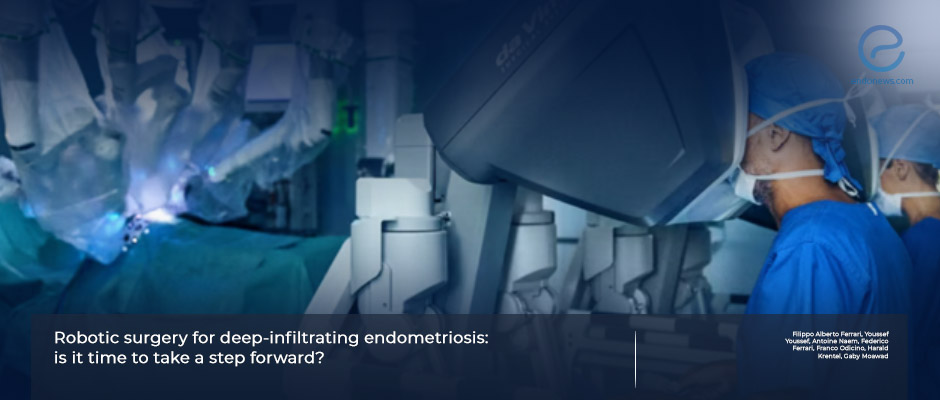Current practice in robotic surgery for deep-infiltrating endometriosis
Apr 12, 2024
A narrative review to compare the robotic and laparoscopic surgeries for the management of deep endometriosis.
Key Points
Highlight
- Excision by Laparoscopic surgery is the gold standard for deep endometriosis treatment. Robotic-assisted surgery was recently adopted for the surgical management of endometriosis.
- Current non-comparative studies reported a comparable complication rate between these minimally invasive surgeries.
Importance
- The quality of the available studies on robotic-assisted surgery in deep endometriosis is low, and long-term results concerning pain relief and pregnancy rates are lacking.
- The procedure's efficacy, cost-effectiveness, and safety have yet to be determined.
What's done here
- This paper summarizes the current practice of robotic surgery in deep-infiltrating endometriosis.
- An international team made a broad-scope search of literature for this narrative review.
Basic outlines
- The studies comparing standard laparoscopic approach and robotic-assisted surgery started in 2010 and are limited.
The majority showed a significantly shorter hospitalization time in the laparoscopic group. - On the other hand, a higher rate of histologic confirmation of endometriosis was achieved in the robotic-assisted surgery group.
- The robotic-assisted surgery seems to be superior in long-term pain relief, quality of life, and fertility results. However, it has a longer operation time in patients with stage III/IV endometriosis.
- Colorectal endometriosis can be operated by segmental excision, discoid resection, or shaving laparoscopically. Although some authors attracted attention to easier superior rectal artery sparing and simple tissue handling during robotic-assisted surgery, a recent prospective study comparing these two approaches showed no difference in blood loss and intra- and postoperative complications.
- Diaphragmatic endometriosis is a rare condition with difficulty in preoperative diagnosis. Complete surgical excision is avoided due to the opening of the thoracic cavity and postoperative catamenial symptoms or chronic pain. Considering the feasibility, safety, and reproducibility of robotic surgery, the team should be aware of the possibility of pneumothorax.
- No prospective study has been published comparing minimally invasive procedures and robotic surgery in the urinary endometriosis and sacral plexus dissection fields.
Lay Summary
Today, surgical excision of endometriotic lesions is the only cytoreductive procedure for managing endometriosis. Hormonal treatment may partly relieve the symptoms, but it suppresses rather than cytoreduction of the disease. Minimally invasive surgery is usually the most preferred method due to reduced blood loss, postoperative pain, and hospitalization. Laparoscopic surgery is recommended in advanced and complex cases but sometimes may result in tissue alterations provoked by adhesions. Compared to 3D robotic surgery, laparoscopic surgery may have some technical limitations such as the disability in range of motion. After receiving approval from the FDA in 2005, robotic-assisted surgery has started to be used in gynecology. It was recently reported that robotic-assisted surgery may have a safer and more precise excision of the disease with less blood loss than laparoscopic surgery alone.
Ferrari et al., from the Department of Obstetrics and Gynecology of the University of Verona, Italy, aimed to update the role of robotic-assisted surgery in endometriosis by conducting a narrative literature review.
The robotic-assisted surgery provides a more ergonomic position, 3D vision, and freedom of wrist movement in deep endometriosis. Complex pelvic pathology, obesity, and prior surgical history are other reasons for some surgeons to prefer this procedure. Its disadvantages include longer operative time, higher costs, and longer staff training.
A prospective randomized controlled single-center trial named ROBEndo trial is ongoing, and it could evaluate the impact of robotic-assisted surgery on deep endometriosis and its postoperative outcomes. After this kind of planned prospective research, the authors announced the possibility and the advantage of getting more information about the long-term results of pain relief and fertility rates.
This narrative review was recently published in the journal Frontiers in Medicine.
Research Source: https://pubmed.ncbi.nlm.nih.gov/38504917/
robotic surgery robotic-assisted surgery diaphragmatic endometriosis colorectal endometriosis urinary endometriosis sacral plexus endometriosis.

